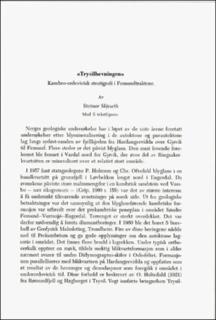| dc.contributor.author | Skjeseth, Steinar | |
| dc.coverage.spatial | 20181 Engerdal | |
| dc.date.accessioned | 2020-08-26T12:53:12Z | |
| dc.date.available | 2020-08-26T12:53:12Z | |
| dc.date.issued | 1962 | |
| dc.identifier.uri | https://hdl.handle.net/11250/2674759 | |
| dc.description.abstract | Diamond drillings carried out 1960 in the vicinity of the lake Femund, near the Swedish border (fig. 1) gave new informations about the cambro-ordovician stratigraphy in the south-eastern miogeosynclinal belt of the Caledonian geosyncline in Norway. An arkosic sandstone rest with erosional discordance on different Cambrian horizons (fig. 3). The stratigraphical position of the formation and finds of graptolithes indicates that it corresponds to the Lower Didymograptus Shale (3b) in the Oslo Region. Prior to the deposition of the formation, the region in question must have been disturbed by epirogenetic movements. This disturbance mentioned by O. Holtedahl has been called the \"Trysil Disturbance\". It can be traced along the Caledonian miogeosynclinal belt from Femund to Hardangervidda (fig. 4). The movement along the margin of the geosyncline led to the formation of a more or less closed basin with graptolite facies on the foreland from the Oslo Region to Scania in Sweden. | |
| dc.language.iso | nor | |
| dc.relation.ispartofseries | NGU (215) | |
| dc.rights | Navngivelse 4.0 Internasjonal | |
| dc.rights.uri | http://creativecommons.org/licenses/by/4.0/deed.no | |
| dc.subject | STØRKNINGSBERGART | |
| dc.subject | PALEOZOIKUM | |
| dc.subject | PETROGRAFI | |
| dc.subject | BORING | |
| dc.subject | STRATIGRAFI | |
| dc.subject | SEDIMENTÆR BERGART | |
| dc.title | "Trysilhevningen". Kambro-ordovicisk stratigrafi i Femundtraktene. | |
| dc.type | Journal article | |
| dc.description.localcode | 36203 | |
| dc.source.pagenumber | 102-113 | |

